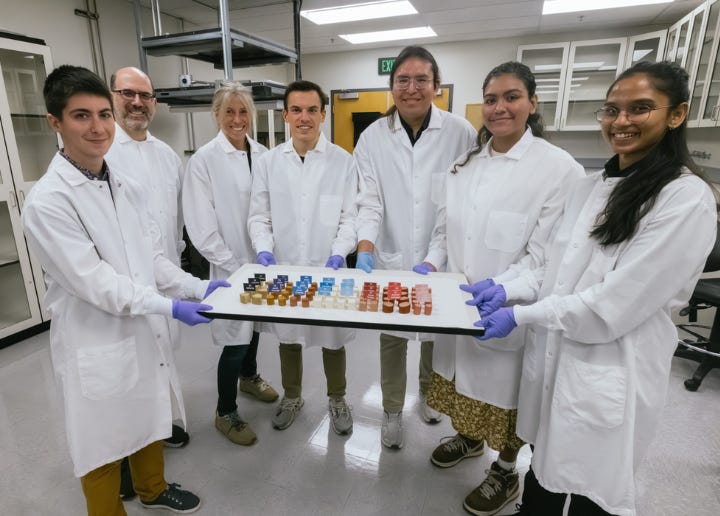
Reducing animal protein consumption is a powerful way to conserve resources and cut greenhouse gas emissions, yet convincing meat lovers to embrace plant-based options remains a hurdle. Tackling this issue with innovation, Stanford engineers are blending mechanical engineering and artificial intelligence to refine food texture testing. This advancement could pave the way for plant-based meats that rival the sensory experience of animal-based counterparts.
‘‘Stanford engineers are breaking barriers in plant-based meat innovation. With cutting-edge mechanical testing and AI, they’ve uncovered how today’s plant-based options can perfectly mimic the texture of animal meat. This game-changing breakthrough brings us closer to a sustainable, mouthwatering future meat lovers won’t be able to resist!’’
The Texture Challenge
Texture plays a pivotal role in the appeal of meat alternatives. It is one of the most difficult attributes to replicate in plant-based products. Traditional methods of analyzing food texture often fall short because they lack standardization and do not always reflect the nuanced human experience of chewing. However, a new study by Stanford researchers, published in Science of Food, offers a groundbreaking solution.
The team used a combination of mechanical testing and machine learning to create a reliable, scalable method for analyzing food textures. Astonishingly, their findings showed that many modern plant-based meats already match the texture spectrum of animal products. "We were surprised to find that today’s plant-based products can reproduce the whole texture spectrum of animal meats," said Ellen Kuhl, senior author of the study and a professor of mechanical engineering.
Why Texture Matters
The stakes are high when it comes to convincing consumers to switch to plant-based alternatives. Despite growing awareness of the environmental impacts of industrial animal agriculture—including climate change, habitat loss, and antibiotic resistance—many consumers are reluctant to change their diets. A recent survey revealed that only about a third of Americans are "very likely" or "extremely likely" to purchase plant-based meat.
“People love meat,” noted Skyler St. Pierre, the study’s lead author. “If we want to convince hardcore meat eaters that alternatives are worth trying, the closer we can mimic animal meat with plant-based products, the more likely people might be open to trying something new.”
By perfecting texture, plant-based meats could win over even the most skeptical meat enthusiasts. Improved texture not only enhances the eating experience but also builds consumer trust, helping plant-based options compete with traditional meats.
Innovations in Food Texture Testing
The Stanford team’s journey began with a class project that evolved into a cutting-edge study. To test food textures affordably, St. Pierre and his peers initially experimented with common items like hot dogs and tofu. These early efforts led to the development of a sophisticated three-dimensional food testing process.
The team analyzed eight food products: animal and plant-based hot dogs, animal and plant-based sausages, animal and plant-based turkey, and two types of tofu. Using a machine designed to simulate chewing, they subjected the samples to pulling, pushing, and shearing forces. “These three loading modes represent what you do when you chew,” explained Kuhl.
The data generated by these tests, combined with machine learning, allowed the researchers to map food textures with unprecedented accuracy. This method has the potential to accelerate the development of plant-based meats by providing food scientists with standardized, actionable insights.
A Path to Sustainable Eating
The environmental benefits of plant-based meats are undeniable. Studies suggest that, on average, these products have half the environmental impact of animal meats. By making plant-based options more appealing, innovations like Stanford’s texture testing could play a critical role in reducing the global reliance on animal agriculture.
This technology could also foster collaboration within the food science community. Traditional texture testing results are often proprietary, limiting innovation. The standardized methods developed by the Stanford team offer a more open, scientific approach, enabling faster advancements in plant-based food technologies.
Looking Ahead
Plant-based meats have come a long way since tofu and seitan were the only options. Thanks to advancements like those from Stanford engineers, the future of plant-based eating looks increasingly promising. By addressing the critical factor of texture, researchers are not only making plant-based meats more enjoyable but also helping to create a more sustainable food system.
As these innovations continue to evolve, the hope is that more consumers will be inspired to make the switch. Whether for the planet, personal health, or ethical reasons, the shift toward plant-based eating is becoming more accessible—and delicious—than ever before.
With tools like mechanical testing and AI paving the way, the vision of a sustainable, plant-based future is no longer just an ideal; it is becoming a reality.
Source: Can AI improve plant-based meats? | Stanford Report
Get my new booklet ‘‘25 Vegan Myths Debunked!’’
This concise guide is invaluable for anyone curious about veganism, offering evidence-based insights and practical guidance to navigate vegan living confidently. All proceeds benefit the promotion of animal rights worldwide!
Visit Our Amazon Store!
Notice: As an Amazon Associate, we earn a commission from qualifying purchases that help promote animal rights worldwide!
General Resources
Books:
Dominion: The Power of Animals in Nature and in Our Imagination by Matthew Scully
Animal Liberation by Peter Singer
Eating Animals by Jonathan Safran Foer
A Billion Hungry Mouths: Feeding the World Without Consuming the Planet by Colin Tudge
Websites and organizations:
Documentaries:
Articles:
"The Case for Animal Rights" by Tom Regan
‘‘Why We Love Dogs, Eat Pigs, and Wear Cows: An Introduction to Carnism’’ by Melanie Joy
‘‘Animal Rights: The Abolitionist Approach’’ by Gary L. Francione
‘‘Fellow Creatures: Our Obligations to the Other Animals’’ by Christine Korsgaard
Seeds of Compassion: Finding Jesus Christ in a Vegan World by Michael Corthell
Receive a single informative article daily at 12:01 AM by email. Explore my homepage with exciting vegan and plant-based news content and delightful and delicious recipes for additional updates. Stay connected to the vegan world and all it has to offer.
Visit The Vegan Project Global our Facebook page for more vegan outreach and education.
The information on this vegan/plant-based blog is for general informational purposes only. It is not intended as legal, medical, or professional advice. Readers should consult with appropriate professionals for specific advice tailored to their situation. The blog owner is not responsible for any reliance on the information herein.





i never liked meat even when i wasn’t horrified and disgusted by it.
i’m glad this is available for the folks who need it but it’s definitely not for me. anything too realistic really grosses me out.